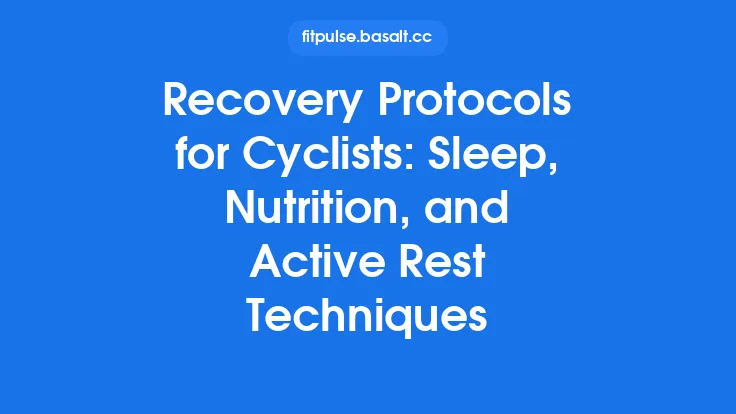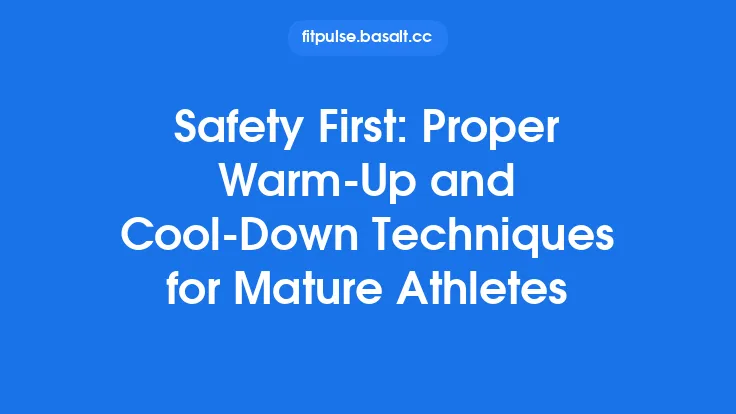Contrast therapy—alternating exposure to cold and heat—has become a staple in the recovery toolbox of many athletes. While commercial contrast tubs and specialized equipment can be pricey, the same principles can be harnessed with everyday items that most people already have at home. This guide walks you through the practical side of setting up, using, and maintaining a DIY contrast therapy system that fits into the busy schedule of the everyday athlete.
Choosing the Right DIY Setup
Before you start gathering supplies, think about the environment where you’ll be performing the therapy. The ideal space should:
- Allow easy access to both hot and cold sources – a bathroom, garage, or a corner of the living room works well.
- Provide a flat, stable surface – a sturdy table, countertop, or a low bench can serve as the base for containers.
- Offer adequate drainage – especially if you plan to use larger tubs or buckets that will overflow.
- Be safe from slip hazards – place non‑slip mats or towels around the area to prevent accidents when moving between temperatures.
By mapping out the space first, you avoid the need for major rearrangements later and keep the process streamlined.
Essential Tools You Can Find at Home
| Item | Typical Use | Tips for Optimization |
|---|---|---|
| Two large plastic containers (e.g., 5‑gallon buckets) | One for hot water, one for cold | Choose containers with wide openings for easy immersion; line the interior with a waterproof liner if you’re concerned about wear. |
| Thermometer (digital or analog) | Monitor water temperature | Keep a spare on hand; a quick‑read digital probe is ideal for rapid checks. |
| Insulating material (e.g., towels, foam pads) | Maintain temperature longer | Wrap the hot container in a towel to reduce heat loss; place a cooler bag around the cold container to keep it chilled. |
| Ice packs or frozen water bottles | Boost cold water chill | Freeze several bottles in advance; they can be rotated to keep the water consistently cold. |
| Timer or stopwatch | Track exposure intervals | Use a phone app or a kitchen timer; set separate alarms for hot and cold phases. |
| Water‑proof bench or stool | Sit comfortably while immersing limbs | A simple garden stool covered with a waterproof sheet works well. |
| Optional: Small submersible pump | Circulate water for even temperature | Useful if you’re using a larger tub and want to avoid temperature stratification. |
All of these items are inexpensive, reusable, and can be stored compactly when not in use.
Building a Simple Contrast Bath System
- Prepare the Hot Bath
- Fill one bucket with warm water (aim for 38‑42 °C / 100‑108 °F).
- Add a small amount of Epsom salt if you enjoy a mild muscle‑relaxing soak; this is optional and does not affect the contrast principle.
- Cover the bucket with a lid or towel to retain heat while you set up the cold side.
- Prepare the Cold Bath
- Fill the second bucket with cold tap water (around 10‑15 °C / 50‑59 °F).
- Add the frozen bottles or ice packs.
- Stir gently to distribute the cold evenly.
- Arrange the Stations
- Place the hot bucket on one side of your work surface and the cold bucket on the opposite side, leaving enough room for you to move comfortably between them.
- Position the timer within sight, and keep the thermometer near each bucket for quick temperature checks.
- Test Run
- Submerge a small body part (e.g., a hand) for a few seconds in each bath to confirm temperatures feel appropriate. Adjust by adding hot water, cold water, or more ice as needed.
Once the basic system is set, you can scale it up (e.g., using a bathtub for full‑body immersion) or down (e.g., using a small basin for just the feet) depending on your goals.
Portable Contrast Packs for On‑the‑Go Athletes
Not every athlete has the luxury of a dedicated space at home. For those who travel, train at a gym, or simply prefer a compact solution, consider these portable kits:
- Dual‑Chambered Inflatable Bags – One chamber can be filled with hot water (using a travel kettle), the other with cold water and ice. The bag’s flexible walls allow you to switch sides quickly.
- Reusable Gel Packs – Keep a set of gel packs in the freezer and another set in a heated lunchbox. Wrap them around the target area and alternate.
- Thermal Wraps with Zippered Compartments – Some sports stores sell wraps that have separate pockets for hot and cold packs, letting you apply contrast directly to a joint or muscle group.
These kits typically weigh under 2 kg and can be slipped into a gym bag, making contrast therapy feasible even on a tight schedule.
Step‑By‑Step Routine for a 15‑Minute Session
A concise, repeatable protocol helps you integrate contrast therapy without overcomplicating your recovery plan.
| Phase | Duration | Action |
|---|---|---|
| Warm‑up | 1 min | Stand near the hot bucket, take a few deep breaths, and mentally prepare. |
| Hot Immersion | 3 min | Submerge the target limb (e.g., both calves) fully in the hot water. Keep the body relaxed; gentle movement can help blood flow. |
| Transition | 30 sec | Quickly stand, shake off excess water, and move to the cold bucket. |
| Cold Immersion | 1 min | Immerse the same limb in the cold water. You may feel a sharp sensation—this is normal. |
| Repeat Cycle | 2 cycles | Alternate hot and cold phases two more times (hot 3 min → cold 1 min). |
| Final Cool‑Down | 1 min | End with a brief cold immersion, then gently towel‑dry. |
| Post‑Session Stretch | 2 min | Perform a light stretch of the treated area to reinforce flexibility. |
Total time: ~15 minutes. Adjust the number of cycles or the length of each phase based on personal tolerance and the size of the body part being treated.
Customizing Temperature Ranges for Different Goals
While the basic hot‑cold ranges work for most athletes, you can fine‑tune them:
- For Acute Soreness – Keep the cold side on the lower end (5‑10 °C / 41‑50 °F) and the hot side slightly milder (35‑38 °C / 95‑100 °F) to avoid aggravating inflamed tissue.
- For Stiffness or Joint Mobility – Raise the hot side to 42‑45 °C (108‑113 °F) and keep the cold side around 12‑15 °C (54‑59 °F) to promote greater tissue elasticity.
- For Warm‑Weather Training – Use a cooler hot bath (around 36 °C / 97 °F) to prevent overheating, while still benefiting from the contrast effect.
Experiment with small adjustments over several sessions, noting how your muscles feel afterward. This trial‑and‑error approach helps you discover the sweet spot for your unique physiology.
Integrating Contrast Therapy into Weekly Training Cycles
To reap consistent benefits, schedule contrast sessions strategically:
- Post‑Intensive Days – Use a full contrast routine after heavy strength or interval workouts when muscle fatigue is highest.
- Recovery Days – A lighter version (shorter hot immersion, longer cold immersion) can be performed on active‑recovery days to keep circulation flowing without adding extra stress.
- Pre‑Competition – A brief contrast “wake‑up” (hot 2 min → cold 30 sec, repeat once) can prime the nervous system and improve joint readiness.
- Off‑Season Maintenance – Incorporate contrast therapy once or twice a week as a general wellness habit, supporting joint health and circulation year‑round.
By aligning the therapy with your training load, you avoid unnecessary redundancy and keep the routine purposeful.
Tracking Recovery and Adjusting Your Protocol
Even a DIY system benefits from a simple tracking method:
- Recovery Log – Record the date, body part treated, temperature settings, and perceived soreness (e.g., on a 1‑10 scale) after each session.
- Performance Correlation – Note any changes in performance metrics (e.g., squat depth, sprint time) in the days following a contrast session.
- Adjustments – If soreness scores remain high, consider extending the cold phase or lowering the hot temperature. Conversely, if you feel overly stiff, increase the hot duration slightly.
Over a few weeks, patterns will emerge, allowing you to refine the protocol without needing sophisticated equipment.
Maintenance, Hygiene, and Longevity of DIY Gear
A well‑maintained setup lasts longer and stays safe:
- Clean Water Daily – Drain and rinse both buckets after each use. Add a splash of mild dish soap if you notice residue, then rinse thoroughly.
- Prevent Mold – Allow containers to air‑dry completely before storing. If you store them in a damp basement, place silica gel packets inside.
- Inspect for Cracks – Plastic can become brittle over time. Replace any bucket showing hairline cracks to avoid leaks.
- Thermometer Calibration – Test your thermometer against a known reference (e.g., boiling water at 100 °C) monthly to ensure accuracy.
- Storage – Keep the containers in a cool, dry place. If you have limited space, stack them vertically with a protective sheet between them.
Regular upkeep ensures that each session feels fresh and reduces the risk of bacterial growth.
Frequently Asked Practical Questions
Can I use a bathtub instead of buckets?
Yes. Fill one side of the tub with hot water and the other with cold water, using a divider (e.g., a waterproof curtain) to keep the temperatures separate. This works well for full‑body contrast but requires more water and careful temperature monitoring.
What if I don’t have a thermometer?
A quick “hand test” can give a rough estimate: the hot water should feel comfortably warm, not scalding, while the cold water should feel brisk but tolerable. However, investing in a low‑cost digital probe (often under $10) pays off in consistency.
Is it okay to combine contrast therapy with compression sleeves?
Yes, as long as the sleeves are not so tight that they restrict blood flow. Light compression can enhance the circulatory effect, but avoid overly restrictive gear during the hot phase.
How many sessions per week are advisable?
For most recreational athletes, 2‑3 sessions per week provide a good balance. Adjust based on training intensity and personal recovery needs.
Can I use this method for upper‑body recovery?
Absolutely. Smaller containers or a kitchen sink can accommodate arms, shoulders, or even the neck. Just ensure the immersion depth covers the target muscles.
By leveraging everyday items and a clear, repeatable process, DIY contrast therapy becomes an accessible, cost‑effective tool for athletes of all levels. The key lies in thoughtful setup, consistent execution, and modest adjustments based on personal feedback. With these practices in place, you can enjoy the rejuvenating benefits of alternating heat and cold without the need for expensive commercial equipment.





